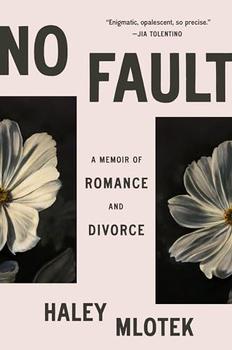Summary | Excerpt | Reviews | Beyond the Book | Read-Alikes | Genres & Themes | Author Bio

A Memoir of Romance and Divorce
by Haley MlotekThis article relates to No Fault
 The title of Haley Mlotek's debut No Fault: A Memoir of Romance and Divorce is a reference to "no-fault" divorce, which is a divorce granted without needing to prove wrongdoing by either spouse. For Mlotek, the legalization of no-fault divorce is an important moment in the history of marriage, as it raises questions about the significance of the institution: If a marriage can be dissolved for any reason, does that undermine its personal symbolism and societal purpose? Those generations who grew up after the advent of no-fault divorce, she writes, have a different understanding of marriage than those who could not take it for granted.
The title of Haley Mlotek's debut No Fault: A Memoir of Romance and Divorce is a reference to "no-fault" divorce, which is a divorce granted without needing to prove wrongdoing by either spouse. For Mlotek, the legalization of no-fault divorce is an important moment in the history of marriage, as it raises questions about the significance of the institution: If a marriage can be dissolved for any reason, does that undermine its personal symbolism and societal purpose? Those generations who grew up after the advent of no-fault divorce, she writes, have a different understanding of marriage than those who could not take it for granted.
Before no-fault, most states required one spouse to provide evidence of the other's marital misconduct, like adultery or cruelty, in order to be granted a divorce, even if both people wanted out. By law, the person who was seeking the divorce had to be free from any "suspicion that he has contributed to the injury of which he complains"—sometimes a high bar. For example, in Oregon in 1935, a judge refused to grant a divorce to a woman who lived in fear of her domineering husband because she was deemed "quarrelsome"—meaning that she had also engaged in bad behavior and neither party had "clean hands."
Because of this, often it was easier for couples who got along well—and who both wanted out—to get a divorce than couples in worse situations. Couples would cooperate to fabricate grounds for their divorce—picking one party as the wrongdoer and sticking to that story on the stand, using the exact wording required by law to describe how they had been abused or victimized (slapped with a certain amount of force, in a certain place, a certain number of times). In fact, a big motivation for introducing no-fault divorce in many states was to reduce perjury in the legal system.
Before New York legalized no-fault divorce in 2010, couples would have to give one of a limited number of reasons for splitting—like adultery, cruelty, or abandonment—so they would just choose one. "What the fault divorce system has done is that it has institutionalized perjury," a matrimonial lawyer said about New York's pre-no-fault system. "This play-acting goes on and everybody looks the other way and follows the script."
On the other hand, lying could work the other way: According to several divorce lawyers interviewed by the New York Times before no-fault divorce was legalized, "there are multimillionaires in New York who have not been faithful but who are keeping their spouses in loveless pairings so as to avoid a division of wealth. They simply deny adultery." In other words, the absence of no-fault divorce incentivized lying both in uncontested divorces, when both partners wanted out and agreed to lie together, and in contested ones, in which one partner would not admit to a cause for divorce, trapping the partner who wanted out.
Today, no-fault divorce is legal in every state in the US, though some states have a waiting period in which a couple may be required to live apart for some time before the divorce goes ahead. California was the first to legalize it, with Governor Ronald Reagan signing it into law in 1969; New York was the last. In every state, divorce rates increased for the next five years or so after it was adopted, then stabilized.
Representation of a divorce, courtesy of cottonbro studio
Filed under Society and Politics
![]() This article relates to No Fault.
It first ran in the March 12, 2025
issue of BookBrowse Recommends.
This article relates to No Fault.
It first ran in the March 12, 2025
issue of BookBrowse Recommends.
The moment we persuade a child, any child, to cross that threshold into a library, we've changed their lives ...
Click Here to find out who said this, as well as discovering other famous literary quotes!
Your guide toexceptional books
BookBrowse seeks out and recommends the best in contemporary fiction and nonfiction—books that not only engage and entertain but also deepen our understanding of ourselves and the world around us.